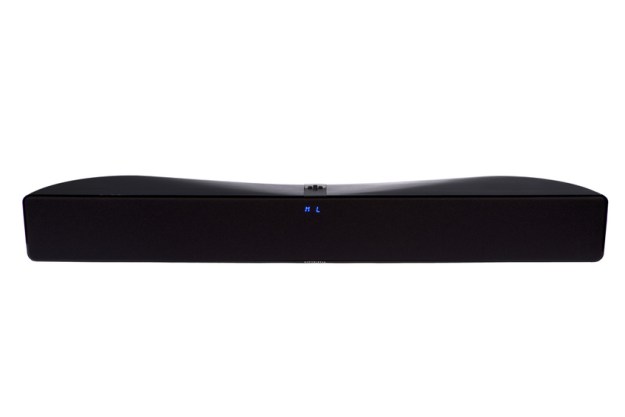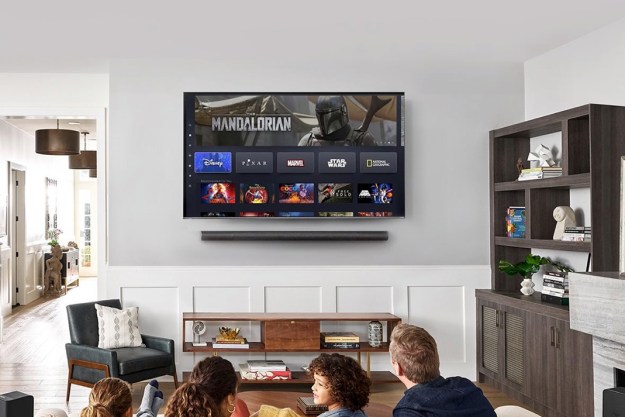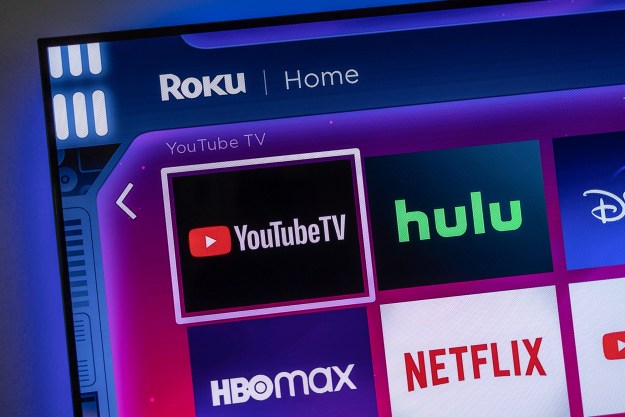
“While there are other strong options in the high-end sound bar space, the Motion Vision distinguishes itself by offering some of the cleanest, most accurate high-frequency response available.”
- Highly musical
- Powerful, deep bass
- Excellent dialog clarity
- Convincing stereo and surround effects
- Built-in wireless sub transmitter
- On-shelf EQ preset results in chesty bass
- Both sound bar and wireless sub solutions are pricey
- Gloss black finish refracts light
Now that sound bars have caught on in a big way, the market has opened up to a more diverse set of options, with prices and features reaching out to both the low-end and high-end extremes. The MartinLogan Motion Vision sound bar fits into the latter category, offering high-quality construction, sleek design, ample power, MartinLogan’s custom “Folded Motion” tweeters, lots of DSP and surround sound processing and, according to its maker, some pretty robust bass.
That all sounds great to us, but $1,500 for a sound bar? Is the woo of a high performance, single-cabinet solution so strong that one would forego a proper home theater rig? You know, $1,500 can net you a respectable 5.1 speaker system and an A/V receiver these days.
Apparently, the answer to our rhetorical question is: yes. MartinLogan is joined by the likes of Bowers and Wilkins, Yamaha and Definitive Technology, all of which have put some considerable engineering efforts toward making bars that sound so big, you won’t miss all those clunky components and rat’s nest of wires. The question is, how does Martin Logan’s (ML) take on the sound bar stack up against its premium pals, and does it earn the extra grand it asks for in comparison to budget bars? We found out.
Out of the box
If, like us, you believe the weight of a speaker has direct implications on its quality, then you’ll be pleased with the Motion Vision sound bar. According to ML, the speaker weighs in at 20.5 lbs, which is just the right amount of heft for a speaker measuring roughly 5 x 40 x 6 (H x W x D –in inches). This is likely due to superior cabinet construction, which passed our knock test with flying colors. Not only did the cabinet bite back a bit, but the resulting sound was a pleasingly dead thunk.

The rear of the gloss-black cabinet undulates a bit to form a shallow s-shape. This may simply be a design choice on the part of ML or it could have functional implications. The bass-reflex ports are channeled along the length of the speaker before opening up to flared holes toward the center of the cabinet, indicating the internal volume of the cabinet has been designed to maximize bass response.
In the box with the sound bar we found a card-style remote control, a wall-mounting template, wall-mounting hardware, power cord, short Toslink (optical) cable and a 3.5 mm headphone to RCA cable.
Features and design
The Motion Vision sound bar offers quite a few notable features, but Martin Logan’s real signature stamp on this product is the inclusion of three of its folded motion tweeters. These tweeters look and act like an accordion, essentially squeezing air to create sound. According to ML, the advantage of this design is less distortion and fast response time. According to us, it sounds fantastic, no matter how it is supposed to work. You can read a little more about our experience with ML’s folded motion tweeters in our review of the company’s Motion LX16 bookshelf speakers.
The three tweeters are mated 4-inch fiber cone drivers. A tweeter/driver pair occupies the sound bar’s extreme left and right edges, with the remaining tweeter sandwiched in between two more 4-inch drivers at the center. ML says the crossover point between the tweeters and low-frequency drivers is 3 kHz.

Seven amplifiers drive each transducer for a total of 100 watts of power. That should work out to about 14 watts for each speaker, assuming the power is evenly distributed.
The rear of the sound bar is outfitted with a comprehensive array of connections, including two digital optical inputs, one digital coaxial input, a set of stereo RCA analog inputs and a subwoofer output. Martin Logan also build’s a wireless subwoofer transmitter into the sound bar. You can use it with the wireless receivers built into the Dynamo Dynamo 1000 and 700 subwoofers.
Under the hood are some proprietary DSP, Dolby Digital and DTS decoders, and virtual surround sound processing. The DSP helps achieve ML’s desired sound signature, but it also supports three sound modes (bass boost, normal and voice), some user-controlled bass level adjustment and an EQ preset that adjusts the speakers sound based on wall-mounted or stand-mounted placement. Notably absent is any Bluetooth wireless audio receiver, which would make use of mobile devices with this speaker much, much easier.

Finally, MartinLogan wisely includes a display, which is hidden behind the Motion Vision’s cloth-covered metallic, removable grill. The display is your bare bones, digital-alarm-clock-style LCD screen which glows blue, is dimmable based on preference and totally disappears after a time-out period. This display, while not on par with the high-class aesthetic that dominates the balances of the sound bar’s design, is essential for navigating the system’s menu, which provides access to all of the speaker’s essential settings.
Setup
We connected the Motion Vision sound bar directly to our Oppo BDP-95 Blu-ray player using one optical digital input and directly to a Samsung UN46ES6500 Smart LED TV using the other. We also fed audio to the sound bar’s analog inputs with the Oppo’s dedicated analog outputs, essentially bypassing the Motion Vision’s built-in DAC (digital to analog converter) in favor of the Oppo’s well-rated DAC.
For this review, we had MartinLogan’s Dynamo 1000 subwoofer on hand, so we linked it to the sound bar’s internal wireless transmitter – a surprisingly quick and easy process. Both pieces were allowed to break-in at moderate volumes for 40 hours prior to evaluation.
Performance
Given MartinLogan’s reputation of building highly musical speakers, and our enthusiasm over the LX16 bookshelf speakers, we put the Motion Vision sound bar to task playing back some of our favorite musical selections. Besides, if you’re going to replace a full-size audio system with a sound bar – especially one costing around $1,500 – it had better sound damn good playing back music.
Oh, but it does.
Right off the bat, we realized we were dealing with an over-achiever. We queued up Marc Broussard’s Keep Coming Back album and proceeded to listen to the entire record. All those other test cuts we had at the ready would end up waiting for a while since, track after track, the Motion Vision sucked us in with its special treatment of each and every instrument.
Not surprisingly, MartinLogan’s folded motion tweeters flexed out some super tasty high-frequency response. Every instrument benefited, but the tweeter’s fast response and deft handling of the sort of delicate transients prevalent in acoustic guitar work was most apparent.
Midrange performance as was also impressive, even if we did long for a bit more meat to some male vocals. Some of the huskiness inherent to Broussard’s voice was lost and even deeper voices, such as Keb Mo’s, lacked just a touch of body that we’re used to hearing from much larger speakers. For its size, though, the Motion Vision sounded quite good.

Bass performance started out a little chesty for us, but after a few adjustments (which we will detail shortly) things slotted in very nicely. The sound bar is capable of delivering enough deep bass such that music never sounded un-supported as it often does with budget sound bars. Later, we would learn this ample bass response benefited the speaker’s integration with a subwoofer for movie soundtracks.
Just as impressive as its sonic balance was the Motion Vision’s ability to extend its sonic presence well outside the confines of its cabinet. We routinely heard extension a good foot or two outside the extreme left and right of the sound bar. Additionally, stereo effects were far superior to any sound bar we’ve formally evaluated to date. The sum effect was a sound bar that sounded far larger than it is, making for a genuinely enriching music listening experience on par with that of small, high-end bookshelf speakers.
For all of the Motion Vision’s outstanding performance, we did notice a few quirks as we worked to dial the sound bar in. First, the built-in EQ preset meant to be used when the sound bar is placed on an entertainment cabinet (labeled “onshelf” in the menu) puts an unnecessary bump in the bass response. We get that when a sound bar is located on a wall, you want to carve out just a bit of bass because the wall serves to reinforce certain frequencies. Likewise, when the sound bar is away from the wall, the bass curve should be adjusted to help fill the room. But, we felt like the on-wall version sounded best, no matter where we placed the speaker. The onshelf option was generally chesty and unflattering.
Other quirks involved a short omission of the first second or so of our music tracks as the speaker’s processor worked to resolve the data stream from our Blu-ray player. This issue wasn’t a problem when we tuned into its analog inputs, where the same tracks played without any interruption in continuity.
After a highly satisfying experience with music listening, we moved on to watch some movie clips, which we assumed the Motion Vision would resolve in a similarly satisfying manner. Our expectations were well exceeded, however.
For movies, we decided to give the sound bar’s “voice” preset a shot. We were very pleasantly surprised at how well the function served to enhance dialog clarity without sacrificing the integrity of the rest of the sound spectrum. Voices leapt out at us from the screen while the remainder of movie soundtracks sat just behind, retaining impact but never covering up important dialog.

Virtual surround sound was less universally impressive, since it wasn’t as effective outside of the “sweet spot,” but from the center seats, we enjoyed that sound effects had a more three-dimensional appeal with the processor engaged than without it. Sometimes we actually got the impression that some sounds came from behind us, but at no point did we feel like the greater sonic picture took a hit. In almost every case from every seat, the virtual surround effect was more enhancement than it was distraction – something we very rarely say about faked surround.
Up until this point, we had gone without a subwoofer, and the Motion Vision did very well without it. Movies had plenty of punch and even just a bit of rumble. We can imagine most folks will be satisfied with the sound bar’s performance as a stand-alone speaker. For those with insatiable appetites for bass and a penchant for ground-shaking movie effects, however, a separate sub is necessary.
We engaged the Dynamo 1000 and, as we expected, it filled out the extreme low end with authority. We’ll reserve our full impressions for a dedicated review on the sub, which is forthcoming. But what we will say for now is that, while it was nice having the integrated wireless subwoofer transmission, any quality subwoofer can be used and will do a good job of picking up where the Motion Visions leaves off. Since the sound bar is capable of good bass below 100Hz, whatever sub is mated to it has the enviable job of restricting its contributions to the very lowest of tones. We integrated an Aperion 8D subwoofer – a budget sub by comparison – and found it did a very fine job mated to the Motion Vision.
Conclusion
Simply put, the MartinLogan Motion Vision is a terrific over-achiever of a sound bar. It is simultaneously eloquent and muscular, as adept at delivering the subtle nuances of your favorite music as well as it is blowing your hair back during a raucous movie scene. While there are other strong options in the high-end sound bar space, the Motion Vision distinguishes itself by offering some of the cleanest, most accurate high-frequency response available.
The only catch is that such high-end performance often comes with an equally high-end price, and that is the case here. With that said, we do prefer the overall sound quality of the Motion Vision sound bar to many more expensive alternatives. At the end of the day, we think the Martin Logan’s take on the sound bar offers some of the best sound available from a space-saving solution no matter the price and, for that, we bestow it our Editor’s Choice award.
Highs
- Highly musical
- Powerful, deep bass
- Excellent dialog clarity
- Convincing stereo and surround effects
- Built-in wireless sub transmitter
Lows
- On-shelf EQ preset results in chesty bass
- Both sound bar and wireless sub solutions are pricey
- Gloss black finish refracts light




